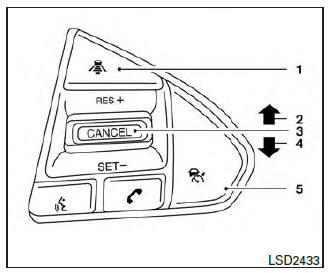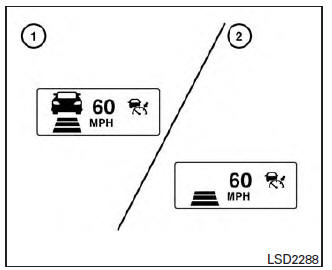Nissan Maxima Owners Manual: The ICC switch

The system is operated by the
CRUISE  switch and four control
switches,
all mounted on the steering wheel.
switch and four control
switches,
all mounted on the steering wheel.
1. DISTANCE switch:
Changes the vehicle's following distance:
- Long
- Middle
- Short
2. RES+ switch: Resumes set speed or increases speed incrementally.
3. CANCEL switch: Deactivates the system without erasing the set speed.
4. SET- switch: Sets desired cruise speed or reduces speed incrementally.
5. CRUISE  switch:
Master switch to activate the system.
switch:
Master switch to activate the system.

The ICC system display and indicators The display is located between the speedometer and tachometer.
1. CRUISE  switch indicator:
switch indicator:
- ICC system ON indicator (white): Indicates
that the CRUISE
 switch is
ON.
switch is
ON. - ICC system SET indicator (green): Indicates that the cruising speed is set.
- ICC system warning (orange): Indicates that if there is a malfunction in the ICC system.
2. Set vehicle speed indicator: Indicates the set vehicle speed.
For Canadian models, the speed is displayed in km/h.
3. Set distance indicator: Displays the selected distance between vehicles set with the distance switch.
4. Vehicle ahead detection indicator: Indicates whether it detects a vehicle in front of you.
Operating ICC

To turn on the cruise control: quickly push
and release the CRUISE switch
A . The
ICC system ON indicator (white), set distance
indicator and set vehicle speed indicator come
on in a standby state for setting.
switch
A . The
ICC system ON indicator (white), set distance
indicator and set vehicle speed indicator come
on in a standby state for setting.

To set cruising speed: accelerate your vehicle to the desired speed, push the SET- switch and release it. The ICC system set indicator (green), vehicle ahead detection indicator, set distance indicator and set vehicle speed indicator B will come on. Take your foot off the accelerator pedal.
Your vehicle will maintain the set speed.
When the SET- switch is pushed under the following conditions, the system cannot be set and the ICC indicators will blink for approximately 2 seconds:
- When traveling below 20 mph (32 km/h) and a vehicle ahead is not detected
- When the shift lever is not in the D (Drive) or Manual mode
- When the parking brake is applied
- When the brakes are operated by the driver
When the SET- switch is pushed under the following conditions, the system cannot be set.
A warning chime will sound and a message will pop up:
- When the VDC system is off (To use the ICC
system, turn on the VDC system. Push the
CRUISE
 switch to turn off
the ICC
system and reset the ICC switch by pushing
the CRUISE
switch to turn off
the ICC
system and reset the ICC switch by pushing
the CRUISE  switch again.)
For additional information about the VDC
sytem, refer to "Vehicle Dynamic Control
(VDC) system" in this section.
switch again.)
For additional information about the VDC
sytem, refer to "Vehicle Dynamic Control
(VDC) system" in this section. - When ABS or VDC (including the TCS) is operating
- When a wheel is slipping (To use the ICC
system, make sure the wheels are no longer
slipping. Push the CRUISE
 switch to
turn off the ICC system, and reset the ICC
system by pushing the
CRUISE
switch to
turn off the ICC system, and reset the ICC
system by pushing the
CRUISE switch again.)
switch again.)
Vehicle detected ahead

When a vehicle is detected in the lane ahead, the ICC system decelerates the vehicle by controlling the throttle and applying the brakes to match the speed of a slower vehicle ahead. The system then controls the vehicle speed based on the speed of the vehicle ahead to maintain the driver selected distance.
- System set display with vehicle ahead
- System set display without vehicle ahead
NOTE:
- The stoplights of the vehicle come on when braking is performed by the ICC system.
- When the brake operates, a noise may be heard. This is not a malfunction.
When a vehicle ahead is detected, the vehicle ahead detection indicator comes on. The ICC system will also display the set speed and selected distance.
Vehicle ahead not detected
When a vehicle is no longer detected ahead, the ICC system gradually accelerates your vehicle to resume the previously set vehicle speed. The ICC system then maintains the set speed.
When a vehicle is no longer detected, the vehicle ahead detection indicator turns off.
If a vehicle ahead appears during acceleration to the set vehicle speed or any time the ICC system is in operation, the system controls the distance to that vehicle.
When a vehicle is no longer detected under approximately 15 mph (24 km/h), the system will be canceled.

When passing another vehicle, the set speed indicator B will flash when the vehicle speed exceeds the set speed. The vehicle detect indicator will turn off when the area ahead of the vehicle is open. When the pedal is released, the vehicle will return to the previously set speed.
Even though your vehicle speed is set in the ICC system, you can depress the accelerator pedal when it is necessary to accelerate your vehicle rapidly.

- System set display with vehicle ahead
- System set display without vehicle ahead
How to change the set vehicle speed
To cancel the preset speed: use one of the following methods:
- Push the CANCEL switch. The set vehicle speed indicator will go out.
- Tap the brake pedal. The set vehicle speed indicator will go out.
- Turn the CRUISE
 switch off.
The ICC
indicators will go out.
switch off.
The ICC
indicators will go out.
To reset at a faster cruising speed: use one of the following methods:
- Depress the accelerator pedal. When the vehicle attains the desired speed, push and release the SET- switch.
- Push and hold the RES+ switch. The set vehicle speed will increase by approximately 5 mph (5 km/h for Canada).
- Push, then quickly release the RES+ switch.
Each time you do this, the set speed will increase by approximately 1 mph (1 km/h for Canada).
To reset at a slower cruising speed: use one of the following methods:
- Lightly tap the brake pedal. When the vehicle attains the desired speed, push the SET- switch and release it.
- Push and hold the SET- switch. The set vehicle speed will decrease by approximately 5 mph (5 km/h for Canada).
- Push, then quickly release the SET- switch.
Each time you do this, the set speed will decrease by approximately 1 mph (1 km/h for Canada).
To resume the preset speed: push and release the RES+ switch. The vehicle will resume the last set cruising speed when the vehicle speed is over 20 mph (32 km/h).
How to change the set distance to the vehicle ahead

The distance to the vehicle ahead can be selected at any time depending on the traffic conditions.
Each time the distance switch A is pushed, the set distance will change to long, middle, short and back to long again, in that sequence.

Distance Approximate distance at 60 mph (100 km/h) [ft (m)]
1. Long 200 (60)
2. Middle 150 (45)
3. Short 90 (30)
- The distance to the vehicle ahead will change according to the vehicle speed. The higher the vehicle speed, the longer the distance.
- If the engine is stopped, the set distance becomes "long". (Each time the engine is started, the initial setting becomes "long".)
Approach warning
If your vehicle comes closer to the vehicle ahead due to rapid deceleration of that vehicle or if another vehicle cuts in, the system warns the driver with the chime and ICC system display.
Decelerate by depressing the brake pedal to maintain a safe vehicle distance if:
- The chime sounds.
- The vehicle ahead detection indicator blinks.
The warning chime may not sound in some cases when there is a short distance between vehicles.
Some examples are:
- When the vehicles are traveling at the same speed and the distance between vehicles is not changing.
- When the vehicle ahead is traveling faster and the distance between vehicles is increasing.
- When a vehicle cuts in near your vehicle.
The warning chime will not sound when:
- The vehicle approaches other vehicles that are parked or moving slowly.
- The accelerator pedal is depressed, overriding the system.
NOTE:
The approach warning chime may sound and the system display may blink when the ICC sensor detects objects on the side of the vehicle or on the side of the road. This may cause the ICC system to decelerate or accelerate the vehicle. The ICC sensor may detect these objects when the vehicle is driven on winding roads, narrow roads, hilly roads, or when entering or exiting a curve.
In these cases you will have to manually control the proper distance ahead of your vehicle.
Also, the radar sensor sensitivity can be affected by vehicle operation (steering maneuver or driving position in the lane) or traffic or vehicle condition (for example, if a vehicle is being driven with some damage).
 ICC system operation
ICC system operation
The ICC system maintains a selected distance
from the vehicle in front of you within the speed
range 0 to 90 mph (0 to 144km/h) up to the set
speed. The set speed can be selected by the
driver ...
 ICC system limitations
ICC system limitations
WARNING
Listed below are the system limitations for
the ICC system. Failure to operate the
vehicle in accordance with these system
limitations could result in serious injury or
death.
The ...
Other materials:
M&A branch line circuit
Diagnosis Procedure
1.CHECK CONNECTOR
Turn the ignition switch OFF.
Disconnect the battery cable from the negative terminal.
Check the terminals and connectors of the combination meter for
damage, bend and loose connection
(unit side and connector side).
2.CHECK HARNESS FOR OPEN CI ...
ECM branch line circuit
Diagnosis Procedure
1.CHECK CONNECTOR
Turn the ignition switch OFF.
Disconnect the battery cable from the negative terminal.
Check the following terminals and connectors for damage, bend and
loose connection (unit side and connector
side).
- Models without automatic drive positione ...
Front wiper does not operate
Description
The front wiper does not operate under any operation conditions
Diagnosis Procedure
1. CHECK WIPER RELAY OPERATION
IPDM E/R AUTO ACTIVE TEST
Start IPDM E/R auto active test. Refer to PCS-11, "Diagnosis
Description".
Check that the front wiper operates at the LO/HI operation. ...
Nissan Maxima Owners Manual
- Illustrated table of contents
- Safety-Seats, seat belts and supplemental restraint system
- Instruments and controls
- Pre-driving checks and adjustments
- Monitor, climate, audio, phone and voice recognition systems
- Starting and driving
- In case of emergency
- Appearance and care
- Do-it-yourself
- Maintenance and schedules
- Technical and consumer information
Nissan Maxima Service and Repair Manual
0.0059
